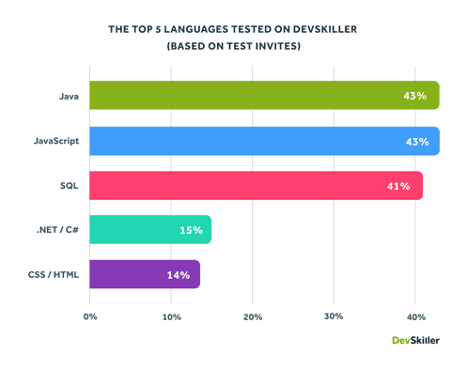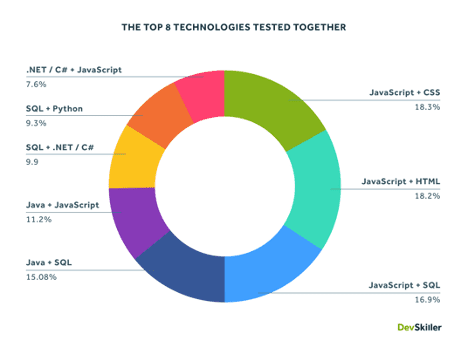JavaScript is used to add and control dynamic web content. Where markup languages like HTML and CSS outline the instructions for rendering static elements, JavaScript drives the features that need to update in real-time. This includes animated graphics, interactive maps, and live videos.
The majority of websites nowadays require content beyond simple images and text, making JavaScript vital to the basic skills of any developer. You don’t necessarily have to be compiling code for blogs and landing pages. JavaScript is also used in several other areas, namely browser games and mobile apps.
If you’re on the fence about its relevance, consider that JavaScript has existed in almost every corner of the internet for over two decades. It’s also worth noting that:
- Java and JavaScript are the most in-demand IT skills for 2021
- JavaScript is the leading language tested with other IT skills
- 75% of organizations are looking for JavaScript developers
These findings come from the latest DevSkiller IT skills report, which is based on data from 304,645 coding tests taken by participants in 156 countries. Before we go any further, let’s briefly explore the aforementioned findings and clarify where JavaScript stands in the current IT job market.
The return of Java
Almost half of all test invites for the 2021 DevSkillers IT skills report featured Java and JavaScript.
The former joined the latter after a two-year hiatus from the top position, while SQL, NET/C#, and CSS/HTML complete the list of the five leading languages. What can we learn from this?
Java returning to the number one spot indicates that more companies are searching for candidates proficient in back-end technologies while frontend development still holds great importance. Here’s how the top five languages tested on DevSkiller are distributed among the rankings:
JavaScript and the competition
Another way to gauge the dominance that JavaScript holds over the IT skills landscape is by reviewing the technologies that are most commonly tested together. When compiling the top 8 results for this year, DevSkiller observed little change over the figures from 2019.
JavaScript + CSS remained in first place, albeit only by a narrow margin (0.1%) to the JavaScript + HTML pairing in second. The podium was shared with JavaScript + SQL, while the fourth and fifth positions went to Java + SQL and Java + JavaScript respectively. Any omission of the latter technologies can only be found in sixth and seventh place.
That section of the rankings is populated by SQL + .NET/C# and SQL + Python. JavaScript makes a final appearance alongside .NET/C# to finish off the list. While the prevalence of Java in these findings is certainly impressive, the most significant trend for 2021 is accredited to the reappearance of Python.
DevSkiller points to usability and back-end functionality as the main draws of the language. They also suggest that the popularity of JavaScript highlights the growing appeal of broad front-end knowledge on developer resumes. In addition, Java and Python are said to reign supreme on the back-end, whereas SQL supports server side-stacks.
Here’s how the languages weigh up on the leaderboard:
- JavaScript + CSS – 18.3%
- JavaScript + HTML – 18.2%
- JavaScript + SQL – 16.9%
- Java + SQL – 15.08%
- Java + JavaScript – 11.2%
- SQL + .NET/C# – 9.9%
- SQL + Python – 9.3%
- .NET/C# + JavaScript – 7.6%
Demand for JavaScript
In the latest DevSkiller roundup of IT skills requested by companies, each of the top 5 entries were held by the same technologies as the 2020 report.
Of course, pole position was taken by JavaScript with 75% of companies looking for developers skilled in the language. SQL came in second, while Java stayed in third place despite slightly dropping in popularity.
HTML/CSS inched closer to the podium after an incremental improvement but remained in fourth. The final spot was secured once more by .NET/C#, which saw similar gains over last year.
These rankings show that SQL is still the preferred IT skill for databases. It’s evident that there’s a growing need for qualified web developers, too. DevSkiller also emphasizes that even though the adoption of .NET/C# has grown, Java maintains its title as the primary tool for solving technical issues.
When it comes to front-end IT skills, JavaScript is the favored technology. The absence of analysis on the shift towards TypeScript is noted in the report and attributed to the way coding tests were classified in the previous year. DevSkiller is placing greater emphasis on distinguishing JavaScript and TypeScript, which will be evident in the next report.
The leading programming languages are demanded by the following percentages of organizations:
- JavaScript – 75%
- SQL – 63%
- Java – 51%
- HTML/CSS – 48%
- .NET/C# – 41%
Opportunities
It’s clear that JavaScript is key to career success in the modern software development industry. Adding the skill to your resume can vastly increase your chances of getting hired and promoted. This applies to various jobs, including:
- Front-end web development (creating user-facing visual elements)
- Web application development (building online programs like file converters and photo editors)
- Website administration (maintaining and upgrading existing sites)
The list extends to professions such as assurance automation specialist and full stack developer. JavaScript also opens the door to positions that lie beyond traditional technology fields. Almost every sector, from banking to insurance to retail, is operating software and websites that utilize JavaScript somewhere.
Learning JavaScript
How can you learn JavaScript and what does it involve?
A great way to start is by leveraging the wealth of resources available online. You can find JavaScript courses on platforms such as Codecademy, Freecodecamp, and Udemy. Be sure to attend local developer meetups and stay active on forums like Github to build your network.
In less than six months, you can teach yourself enough about the language to become competent. However, the learning doesn’t end there. It continues throughout your career as new applications and techniques are always emerging.
When are you adding JavaScript to your IT skill set? It stands to reason that now is the time.
































